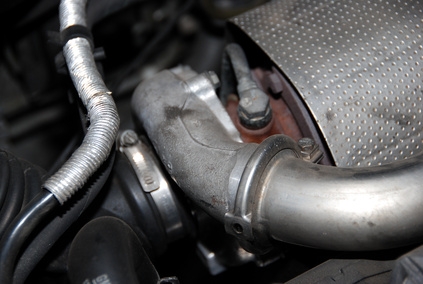
Turbochargers are a well known power maker in the automotive universe; these exhaust-driven compressors have been shoving air into motors for longer than most people on Earth have been alive. Turbochargers can make your engine both powerful and efficient, but they can also blow it into shrapnel if not used with the proper precautions. The primary problem is detonation; that extra air provided by the turbocharger can easily overwhelm the amount of fuel going in, leading to an uncontrolled lean-burn condition and subsequent engine failure.
Install either a boost-actuated or electronically-actuated wastegate. The wastegate will act as a bypass, routing exhaust gases around the turbocharger's impeller blade to limit its RPM at a pre-determined boost pressure level. A mechanical wastegate will work for most applications, but an electronic one will allow you to adjust boost on the fly to compensate for fuel octane, fuel quality and altitude. If you do nothing else, consider a wastegate as mandatory equipment.
Add a blowoff valve. The blowoff valve is a pressure relief valve that sits in the tubing between the turbocharger and the engine's intake. Blowoff valves prevent the pressure surges that can occur under certain conditions; these surges cannot only damage your turbocharger, they can cause a spike in the air/fuel ratio and instant engine meltdown.
Install an intercooler. An intercooler is a type of radiator that cools the pressurized air coming out of the turbo. This is an important consideration since air heats as it's compressed, and hot air going into the engine will cause detonation. Intercoolers can actually help the engine produce more power by safely permitting more boost than possible without one.
Install a higher capacity fuel pump, larger diameter fuel lines, larger diameter fuel rails and higher capacity fuel injectors. At some point, the turbo will push so much air into the engine that the fuel system will fail to keep up. In the best case scenario, running short of fuel will simply limit the engine's RPM and power potential. The worst case scenario is that the fuel system falls far short in the lower RPM band, leading to a lean-burn condition and fried pistons.
Re-tune your engine's computer for the turbocharger and larger fuel injectors. The engine's computer needs to know exactly how much fuel is flowing through the injectors; installing larger injectors, without re-tuning the computer, will result in a fuel-rich condition at idle and under cruise, leading to poor idle quality, increased emissions, reduced power, lower fuel economy and a possible lean condition at high RPM. Re-tuning is a good option if you're running five lbs. of boost or less, but may not even be possible for engines with certain computers and injection system types.
Install an aftermarket fuel management unit. The problem with simply re-tuning the stock computer to compensate for larger injectors is that the computer receives no feedback relating to boost. While careful tuning may allow you to keep the motor alive, you'll never be able to precisely control the fuel-to-boost ratio without an aftermarket computer. Most factory, non-turbo applications will require some sort of aftermarket fuel enrichment system past about five PSI.